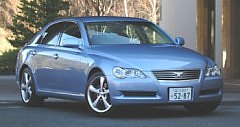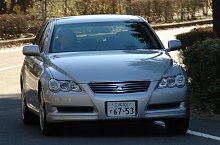|
 After
surviving for 36 years, the Mark II nameplate finally gave way to Mark
X – this is the alphabetic letter X which stands for an unknown.
Interestingly, the car is really entering an uncertain time. Mark II
used to be a Japan-bounded sports sedan. Car enthusiasts liked to tune
it with stiff suspensions and boost its turbocharger to deliver big
power. But globalisation is crumpling the unique breed of Japanese
cars. As Toyota is to start selling Lexus in its domestic market, Mark
X will find its survival space threatened by Lexus GS and IS. After
surviving for 36 years, the Mark II nameplate finally gave way to Mark
X – this is the alphabetic letter X which stands for an unknown.
Interestingly, the car is really entering an uncertain time. Mark II
used to be a Japan-bounded sports sedan. Car enthusiasts liked to tune
it with stiff suspensions and boost its turbocharger to deliver big
power. But globalisation is crumpling the unique breed of Japanese
cars. As Toyota is to start selling Lexus in its domestic market, Mark
X will find its survival space threatened by Lexus GS and IS.
In fact, the Mark X already overlaps with Lexus GS in many ways. Both
cars and Toyota Crown actually share the same rear-drive platform with
2850 mm wheelbase. While Crown is styled more conservatively and
equipped luxuriously to please older buyers, the Mark X and GS are
supposed to attract young and keen drivers. Worse still, a switch to a
normally aspirated V6 seriously limited the tuning potential of Mark X,
as did the electronic variable damping suspension.
That
leaves the packaging to differ them. Lexus GS was styled with strong
European flavour. In contrast, Mark X looks slimmer and lighter, with a
clearly defined 3-box profile. Its soft-techno look has strong Japanese
character, although you cannot describe it as beautiful. The Japanese
techno fashion continues in the cabin. Its instrument panel is
illuminated by cool-looking blue LED, the multi-purpose LCD screen on
the center console is decorated with a stylish faux aluminum panel.
This cabin looks more exciting than that of the Lexus GS.
  Build quality is close to Lexus
level. Most plastics are high quality, as are the wood and optional
leather. But most Mark X will be sold with the standard cloth seat
whose dark color doesn't look as inviting. The cabin is not as
comfortable as Lexus and Crown, especially at the back. The rear seat
is too flat to be comfortable, a trade-off for its folding seat back.
It is also mounted too low in the cabin, therefore the middle passenger
has his legroom seriously blocked by the large transmission tunnel.
This means Mark X is more a 4-seater than 5-seater. Build quality is close to Lexus
level. Most plastics are high quality, as are the wood and optional
leather. But most Mark X will be sold with the standard cloth seat
whose dark color doesn't look as inviting. The cabin is not as
comfortable as Lexus and Crown, especially at the back. The rear seat
is too flat to be comfortable, a trade-off for its folding seat back.
It is also mounted too low in the cabin, therefore the middle passenger
has his legroom seriously blocked by the large transmission tunnel.
This means Mark X is more a 4-seater than 5-seater.
Open the bonnet, you will discover either a 2.5 or 3.0-litre V6, both
completed with aluminum block, 24 valves, dual VVT-i and direct
injection. The 3-litre engine is actually the same one as Lexus GS300,
although it is rated at 256 horsepower (vs 245 hp) according to JIS
standard. The Mark X lost the Lexus' extensive sound insulation, so
from the cabin you can hear the sporty exhaust roar of the V6. Because
its is 90 kg lighter than the equivalent Lexus, you can feel more
lively performance from the same V6.
The Mark X has its suspensions set very stiff, not only by Japanese
standard but also in relation to Lexus GS. With the electronic damping
at Normal mode, the Mark X already rides firmly and resists body roll
very well, but it fails to filter the shocks from small irregularities
on the road, resulting in a fair amount of harshness and noise. This is
a common problem for many air suspensions, but Mark X did not employ
sufficient measures to filter the noise and harshness from the cabin.
If you change the damping to Sport mode, you will find even harder ride
but no decisive improvement in the already fine body control.
 The electric power steering is
not very feelsome, but it is quick and precise. The Mark X displays so
much less understeer than its predecessor, but it is not tuned for
power slide either. Buy a European executive car if you love driving
excitement. Or if you insist Japanese car, wait for the forthcoming
Lexus IS. The electric power steering is
not very feelsome, but it is quick and precise. The Mark X displays so
much less understeer than its predecessor, but it is not tuned for
power slide either. Buy a European executive car if you love driving
excitement. Or if you insist Japanese car, wait for the forthcoming
Lexus IS.
The Mark X shares most components with Lexus GS. However, the lower
grade equipment and the availability of 2.5-litre engine allow it to be
priced lower in the domestic market. It will be seen as a cheaper and
rawer alternative to the Lexus. Nevertheless, in an increasingly open
domestic market, its future is still a factor X. |